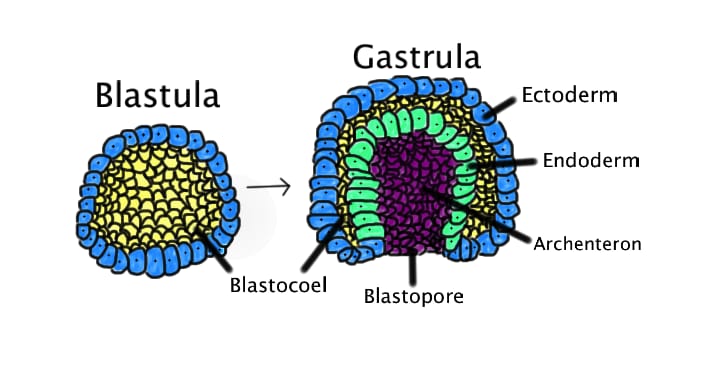MCQ ON GASTRULATION class 11 for NEET | GASTRULATION class 11 | MCQ GASTRULATION with Answer | Check the below NCERT MCQ question for class 11Biology based on the with Answers.

MCQ ON GASTRULATION class 11 for NEET
MCQ on GASTRULATION class 11 Biology with answers were prepared based on the latest pattern.We have provided class 11 Biology MCQs question with Answers to help students understand the concept very well.
MCQ ON GASTRULATION is useful for NEET / CSIR / UGC / CBSE / ICSE / AIIMS / EXAM / AFMC EXAM / STATE LEVEL MEDICAL EXAM 2022-23 , 2023-24
INTRODUCTION:-
Transformation of the blastula into the gastrola with the three primary germ layer by rearrangement of cells is called gastrulation.
The germ layers are formed by characteristic movements of some of the cells at on near the surface of embryonal knob to their new or more interior locations. These cellular movements are known as morphogenetic movement.
Cell movement is accompanied by changes in cell shape and changes in cellular adhesion to other cells.
There are three germ layers :-ectoderm, mesoderm and endoderm .They serve as the initial rudiments of all the future tissues and organs of the offspring body.
Each germ layer gives rise to specific tissues, organs and organ – system of the young one to be developed.
MCQ ON GASTRULATION OR FORMATION OF GERM LAYERS class 11 for NEET
1. Transformation of the blastula into the gastrula with three primary germ layer by rearrangement of the cells is called
(a) morula
(b) gastrulation
(c) blastula
(d) organogenesis
Ans (b) gastrulation
2. During cleavage , nucleocytoplasmic ratio
(a) increase
(b) decrease
(c) remains same
(d) none of these
Ans. (a) increase
3. When do the three germinal layer differentiate?
(a) Blastula
(b) Gastrula
(c) Cleavage
(d) Fertilization
Ans. (b) Gastrula
4.Ectoderm produces
(a) Mesodaeum
(b) Proctodaeum
(c) Stomodaeum
(d) both b and c
Ans.(d) both b and c
5. The cellular movements during formation of germ layer is called
(a) morphogenetic movement
(b) cytolysis
(c) karyokines
(d) cellular movements
Ans.(a) morphogenetic movement
6. The blastocyte continues to grow in the size by observing uterine fluid through the trophoblast. With the growth of the blastocyte, after the formation of endoderm, the embryonal knob is stretched and it’s cells become columnar and come to lie as a regular layer called as
(a) embryonic disc
(b) amniotic sac
(c) endoderm formation
(d) all the above
Ans.(a) embryonic disc
7. The embryonic disc consists of regions:-
(a) cephalic margins
(b) embryonic disc proper
(c) caudal margin
(d) all the above
Ans.(d) all the above
8. A space appears between the embryonal disc and the trophoblast, this is called
(a) amniotic cavity
(b) formation of mesoderm
(c) formation of amniotic disc
(d) none of these
Ans.(a) amniotic cavity
9. Which separates the yolk sac and amniotic cavity from the trophoblast?
(a) endoderm
(b) mesoderm
(c) ectoderm
(d) none of these
Ans. (b) mesoderm
10. After the formation of the mesoderm , the remaining cells of the embryonic disc get arranged in a layer called
(a) mesoderm
(b) endoderm
(c) ectoderm
(d) none of these
Ans. (c) ectoderm
11. Which consists of trophoblast lined by parietal extraembryonic mesoderm ?
(a) Amnion
(b) Chorion
(c) allantoise
(d) all the above
Ans.(b) chorion
12. Which is consist of amniogenic cells covered by visceral extraembryonic mesoderm?
(a) Chorion
(b) Amnion
(c) Allantoise
(d) none of these
Ans . (b) Amnion
13. Amniotic cavity is filled with fluid is called
(a) amniotic fluid
(b) amniotic sac
(c) amniotic disc
(d) none of these
Ans.(a) amniotic fluid
14.During cleavage
(a) size of early embryo increases
(b) size of early in embryo decreases
(c) size of resulting cells increases
(d) size of realting cells decreases
Ans. (d) size of resulting cells decreases
15. In the developing human body, the ectoderm produces
(a) nervous system
(b) lens of the eye
(c) sweat glands
(d) all of these
Ans.(d) all of these
ALSO READ:-
● YOU CAN WATCH BIOLOGY SIR Youtube channel
16. Notochord develops from
(a) primary ectoderm
(b) primary endoderm
(c) primary mesoderm
(d) both a and b
Ans.(c) primary mesoderm







Leave a Comment